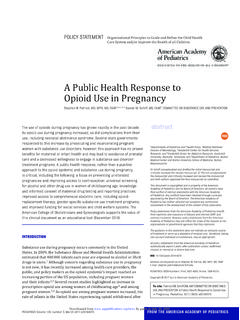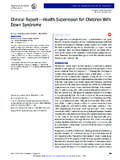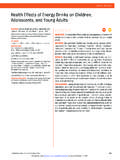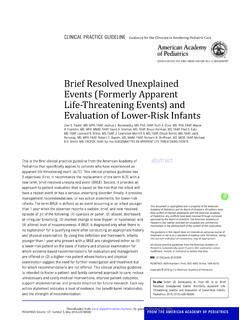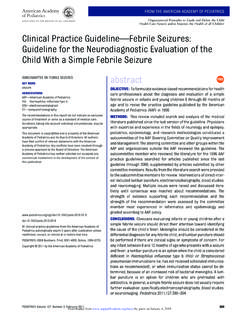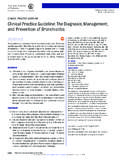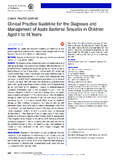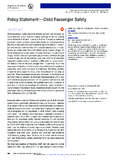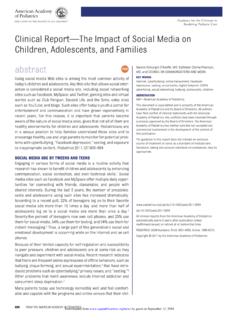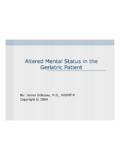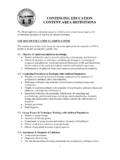Transcription of POLICYSTATEMENT Sensory Integration Therapies …
1 Organizational Principles to Guide and De ne the Child Health Care System and/or Improve the Health of all children POLICY STATEMENT. Sensory Integration Therapies for children With Developmental and Behavioral disorders abstract SECTION ON COMPLEMENTARY AND INTEGRATIVE MEDICINE. and COUNCIL ON children WITH DISABILITIES. Sensory -based Therapies are increasingly used by occupational thera- KEY WORDS. Sensory Integration , Sensory processing, Sensory Integration pists and sometimes by other types of therapists in treatment of children therapy with developmental and behavioral disorders . Sensory -based Therapies This document is copyrighted and is property of the American involve activities that are believed to organize the Sensory system Academy of Pediatrics and its Board of Directors.
2 All authors by providing vestibular, proprioceptive, auditory, and tactile inputs. have led con ict of interest statements with the American Brushes, swings, balls, and other specially designed therapeutic or rec- Academy of Pediatrics. Any con icts have been resolved through a process approved by the Board of Directors. The American reational equipment are used to provide these inputs. However, it is un- Academy of Pediatrics has neither solicited nor accepted any clear whether children who present with Sensory -based problems have commercial involvement in the development of the content of an actual disorder of the Sensory pathways of the brain or whether this publication. these de cits are characteristics associated with other developmental All policy statements from the American Academy of Pediatrics automatically expire 5 years after publication unless reaf rmed, and behavioral disorders .
3 Because there is no universally accepted revised, or retired at or before that time. framework for diagnosis, Sensory processing disorder generally should not be diagnosed. Other developmental and behavioral disorders must always be considered, and a thorough evaluation should be completed. Dif culty tolerating or processing Sensory information is a characteristic that may be seen in many developmental behavioral disorders , includ- ing autism spectrum disorders , attention-de cit/hyperactivity disorder, developmental coordination disorders , and childhood anxiety disorders . Occupational therapy with the use of Sensory -based Therapies may be acceptable as one of the components of a comprehensive treatment plan. However, parents should be informed that the amount of research regard- ing the effectiveness of Sensory Integration therapy is limited and incon- clusive.
4 Important roles for pediatricians and other clinicians may include PEDIATRICS (ISSN Numbers: Print, 0031-4005; Online, 1098-4275). discussing these limitations with parents, talking with families about a tri- Copyright 2012 by the American Academy of Pediatrics al period of Sensory Integration therapy, and teaching families how to evaluate the effectiveness of a therapy. Pediatrics 2012;129:1186 1189. BACKGROUND: DEVELOPMENT OF THE Sensory SYSTEM. Sensory Integration is a framework rst described by occupational therapist A. Jean Ayres, PhD, in the 1970s. It refers to the body's way of handling and processing Sensory inputs from the Ayres felt that the Sensory system develops over time, much like other aspects of development (language, motor, etc), and that de cits can occur in the process of developing a well-organized Sensory sys- tem.
5 A well-organized Sensory system can integrate input from multiple sources (visual, auditory, proprioceptive, or vestibular). Ayres postu- lated that Sensory Integration dysfunction occurs when Sensory neu- rons are not signaling or functioning ef ciently, leading to de cits in development, learning, and/or emotional regulation. 1186 FROM THE AMERICAN ACADEMY OF PEDIATRICS. Downloaded from by guest on August 15, 2018. FROM THE AMERICAN ACADEMY OF PEDIATRICS. The ability of the brain to process a developmental disorder amenable difference for this group. For older Sensory information from the environ- to therapy and that treatment can children and adolescents, no com- ment has been an expanding area of improve developmental monly accepted de nition of Sensory basic neuroscience research.
6 Hubel and A de nition of Sensory processing processing disorder exists. Some Wiesel were among the rst to docu- disorder has been proposed but has experts have proposed that the de - ment the important effects of early not been universally Stand- nition of autism spectrum disorders experience (eg, deprivation) on the way ardized measures, such as the Sen- in the forthcoming Diagnostic and visual Sensory input is processed in the sory Pro le,19 have been developed to Statistical Manual of Mental Dis- 5 Animal and human research is classify a child's Sensory de cits. The orders, Fifth Edition be expanded to beginning to explore how other senses Sensory Pro le provides a standard include de nitions of associated sen- are processed and integrated6 10 and method for professionals to measure sory issues, such as under- and over- how those processes are disrupted a child's Sensory processing abilities responsiveness; however, the committee in speci c syndromes (eg, autism,11,12 and to provide a pro le of the effect that is preparing the textbook has re- schizophrenia13,14) and by speci c ex- of Sensory processing on functional quested that more studies be per- periences (eg, institutionalization, inter- performance in the daily life of a formed before Sensory processing national adoption15,16).
7 Such standardized measures are com- disorder can be of cially monly used by occupational therapists It remains unclear whether children STATEMENT OF THE PROBLEM to quantify how much these devel- who present with ndings described opmental and behavioral differences as Sensory processing dif culties have Since Ayres1 described Sensory in- tegration dysfunction in the 1970s, affect the child's functional performance an actual disorder of the Sensory of the daily activities of childhood. pathways of the brain or whether these Sensory -based Therapies have been used increasingly, mainly by occupa- The possible diagnosis of Sensory pro- de cits represent differences asso- tional therapists (but sometimes other cessing disorders remains a challenging ciated with other developmental and health professionals) to treat a range of clinical issue.
8 In the Sensory processing behavioral disorders . Speci cally, the symptoms seen in children presenting disorder classi cation system proposed behavioral differences seen in chil- from across a variety of settings, in- by Miller et al,18 Sensory processing dren with autism spectrum disorders ,24. cluding the home, community organ- disorders are subdivided into 3 speci c attention-de cit/hyperactivity disorder,25. izations, clinics, and schools. Sensory patterns: Sensory modulation disorder, and developmental coordination dis- Integration , Sensory diets, and other Sensory discrimination disorder, and orders26 overlap symptoms described Sensory -based Therapies typically are Sensory -based motor disability. These in children with Sensory processing based on classic Sensory integra- patterns are then categorized into sub- disorders .
9 Studies to date have not tion theory but often do not use all types. Sensory modulation disorder is demonstrated that Sensory Integration of the originally described Sensory subdivided into overresponsive, under- dysfunction exists as a separate disorder Integration protocols. Sensory -based responsive, and Sensory seeking/craving distinct from these other developmental Therapies involve activities that are subtypes. Sensory discrimination dis- disabilities. Furthermore, numerous believed to organize the Sensory sys- order has no subtypes. Sensory -based challenges exist for evaluating the tem, by providing vestibular, proprio- motor disability is subdivided into pos- effectiveness of Sensory Integration ceptive, auditory, and tactile inputs, by tural disorder and dyspraxia.
10 Therapy, including the wide spectrum using brushes, swings, balls, and other Sensory processing disorder or a of symptom severity and presentation, specially designed equipment to pro- similar diagnosis has been included in lack of consistent outcome measures, vide these inputs. Occupational thera- Zero to Three's Diagnostic Classi ca- and family factors, which make re- pists and other health professionals tion of Mental Health and Develop- sponse to therapy 29. may also use a Sensory processing ap- mental disorders of Infancy and Early Despite the challenges of de ning and proach when identifying and modifying Childhood Revised21 and the Diag- studying the effectiveness of Sensory barriers that limit the individual's ability nostic Manual for Infancy and Early Integration therapy, it is possible that to participate in everyday activities Childhood of the Interdisciplinary the treatment of Sensory processing or occupations.
